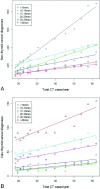An exponential growth in incidence of thyroid cancer: trends and impact of CT imaging
- PMID: 24113469
- PMCID: PMC7965799
- DOI: 10.3174/ajnr.A3743
An exponential growth in incidence of thyroid cancer: trends and impact of CT imaging
Abstract
Background and purpose: Workup of incidental thyroid nodules detected on CT imaging could be contributing to the increased diagnosis of small thyroid cancers. The purpose of this study was to evaluate recent trends in the incidence of thyroid cancer, and to determine the relationship between annual CT imaging volume and rate of thyroid cancer diagnosis.
Materials and methods: This retrospective cohort study used data bases for thyroid cancer and CT imaging volume. Thyroid cancer data from 1983-2009 were obtained from the Surveillance, Epidemiology, and End Results data base. National Council of Radiation Protection and Measurements Report No. 160 provided data on hospital and nonhospital CT imaging volume for 1993-2006. Trends in thyroid cancer were modeled for overall incidence on the basis of patient age, tumor histologic features, and tumor size and stage. Linear regression analysis was performed to evaluate the strength of the relationship between annual CT scan volume and the incidence of thyroid cancer by tumor size and histologic type.
Results: In 2009, the incidence of thyroid cancer was 14 per 100,000, which represented a 1.9-fold increase compared with 2000. The growth in incidence was exponential compared with a minimal linear increase in thyroid cancer mortality rate. The subgroup with the greatest change was subcentimeter papillary carcinoma, with doubling in incidence approximately every 6.2 years. The linear relationship between annual CT scan volume and the incidence of subcentimeter papillary carcinoma was very strong (R(2) = 0.98; P < .0001).
Conclusions: The incidence of subcentimeter papillary carcinoma is growing at an exponential rate without significant change in mortality rate. The strong linear relationship between new cases of subcentimeter papillary carcinomas and the number of CT scans per year suggests that an increase in CT scans may increase the detection of incidental thyroid cancers.
Figures



References
-
- Davies L, Welch HG. Increasing incidence of thyroid cancer in the United States, 1973–2002. JAMA 2006;295:2164–67 - PubMed
-
- McLeod DS, Sawka AM, Cooper DS. Controversies in primary treatment of low-risk papillary thyroid cancer. Lancet 2013;381:1046–57 - PubMed
-
- Etzioni R, Penson DF, Legler JM, et al. . Overdiagnosis due to prostate-specific antigen screening: lessons from U.S. prostate cancer incidence trends. J Natl Cancer Inst 2002;94:981–90 - PubMed
-
- Frates MC, Benson CB, Charboneau JW, et al. . Management of thyroid nodules detected at US: Society of Radiologists in Ultrasound consensus conference statement. Radiology 2005;237:794–800 - PubMed
MeSH terms
LinkOut - more resources
Full Text Sources
Other Literature Sources
Medical
